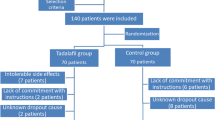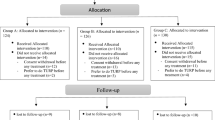Abstract
Objective
To explore the efficacy of levofloxacin, terazosin, and their combination in patients with category III chronic prostatitis/chronic pelvic pain syndrome (CP/CPPS).
Methods
A total of 115 patients with category III CP/CPPS receiving 6-week therapy were randomly divided into the levofloxacin group (n = 38), terazosin group (n = 38), and combination group (n = 39). The primary endpoint was the response rate (i.e., the change from baseline) in the total and domain scores of the National Institutes of Health Chronic Prostatitis Symptom Index (NIH-CPSI). Secondary endpoints were expressed as prostatic secretion-white blood cell (EPS-WBC) and International Index of Erectile Function-5 (IIEF-5).
Results
After 6 weeks, the response rate of NIH-CPSI scores was 45.1, 22.4, and 50.0 % in the levofloxacin group, terazosin group, and combination group, respectively. Furthermore, no significant difference in NIH-CPSI scores was observed between IIIA and IIIB patients in each arm. Levofloxacin alone or levofloxacin plus terazosin could significantly reduce EPS-WBC counts compared with terazosin alone. Finally, no significant difference was found between the three arms in terms of IIEF-5 scores.
Conclusion
A 6-week short-term treatment of levofloxacin or levofloxacin plus terazosin was more effective than terazosin alone in patients with category III CP/CPPS. Furthermore, levofloxacin treatment was not different from levofloxacin plus terazosin treatment in terms of treatment effect.

Similar content being viewed by others
References
Krieger JN, Lee SW, Jeon J et al (2008) Epidemiology of prostatitis. Int J Antimicrob Agents 31(Suppl 1):S85–S90
Nickel JC, Shoskes DA, Wagenlehner FM (2013) Management of chronic prostatitis/chronic pelvic pain syndrome (CP/CPPS): the studies, the evidence, and the impact. World J Urol 31:747–753
Nickel JC, Narayan P, McKay J, Doyle C (2004) Treatment of chronic prostatitis/chronic pelvic pain syndrome with tamsulosin: a randomized double-blind trial. J Urol 171:1594–1597
Krieger JN, Nyberg L Jr, Nickel JC (1999) NIH consensus definition and classification of prostatitis. JAMA 282:236–237
Mehik A, Alas P, Nickel JC et al (2003) Alfuzosin treatment for chronic prostatitis/chronic pelvic pain syndrome: a prospective, randomized, double-blind, placebo-controlled, pilot study. Urology 62:425–429
Moher D, Schulz KF, Altman DG (2001) The CONSORT statement: revised recommendations for improving the quality of reports of parallel-group randomised trials. Lancet 357:1191–1194
Jeong CW, Lim DJ, Son H et al (2008) Treatment for chronic prostatitis/chronic pelvic pain syndrome: levofloxacin, doxazosin and their combination. Urol Int 80:157–161
Nickel JC, Downey J, Johnston B, Clark J, Group TC (2001) Canadian prostatitis research group: predictors of patient response to antibiotic therapy for the chronic prostatitis/chronic pelvic pain syndrome: a prospective multicenter clinical trial. J Urol 165:1539–1544
Krieger JN, Riley DE, Roberts MC et al (1996) Prokaryotic DNA sequences in patients with chronic idiopathic prostatitis. J Clin Microbiol 34:3120–3128
Zhu QF, Xie H, Weng ZL et al (2009) Detection of bacterial signal of 16S rRNA gene in prostate tissues obtained by perineal approach from patient with chronic pelvic pain syndrome. Zhonghua Yi Xue Za Zhi 89:823–825
Park H, Sim SM, Lee G (2015) The presence of Chlamydia is associated with increased leukocyte counts and pain severity in men with chronic pelvic pain syndrome. Urology 85:574–579
Ouzounova-Raykova V, Ouzounova I, Mitov IG (2010) May Chlamydia trachomatis be an aetiological agent of chronic prostatic infection? Andrologia 42:176–181
Cai T, Wagenlehner FM, Mondaini N et al (2014) Effect of human papillomavirus and Chlamydia trachomatis co-infection on sperm quality in young heterosexual men with chronic prostatitis-related symptoms. BJU Int 113:281–287
Naber KG, Weidner W (2000) Chronic prostatitis-an infectious disease? J Antimicrob Chemother 46:157–161
Bjerklund Johansen TE, Gruneberg RN, Guibert J et al (1998) The role of antibiotics in the treatment of chronic prostatitis: a consensus statement. Eur Urol 34:457–466
Nickel JC, Krieger JN, McNaughton-Collins M et al (2008) Alfuzosin and symptoms of chronic prostatitis-chronic pelvic pain syndrome. N Engl J Med 359:2663–2673
Nickel JC, Elhilali M, Emberton M et al (2006) The beneficial effect of alfuzosin 10 mg once daily in ‘real-life’ practice on lower urinary tract symptoms (LUTS), quality of life and sexual dysfunction in men with LUTS and painful ejaculation. BJU Int 97:1242–1246
Andersson KE, Gratzke C (2007) Pharmacology of alpha1-adrenoceptor antagonists in the lower urinary tract and central nervous system. Nat Clin Pract Urol 4:368–378
Acknowledgments
The authors thank all patients for their participation and all study investigators for their contribution to data acquisition and patient care. Jianxin Wang and Dongliang Yan were responsible for data acquisition and data analysis, and they wrote the first draft of the manuscript. Statistical analyses were programmed by Kuixiang Liang. Zhonghua Xu was responsible for the study design, interpretation of data, critical appraisal, and revision of the article.
Funding support
This research received no specific grant or financial support from any funding agency in the public, commercial, or not-for-profit sectors.
Author information
Authors and Affiliations
Corresponding author
Ethics declarations
Conflict of interest
The authors declare that “we have no conflict of interest” in the publication of the above manuscript.
Rights and permissions
About this article
Cite this article
Wang, J., Yan, D., Liang, K. et al. A randomized controlled trial of levofloxacin, terazosin, and combination therapy in patients with category III chronic prostatitis/chronic pelvic pain syndrome. Int Urol Nephrol 48, 13–18 (2016). https://doi.org/10.1007/s11255-015-1147-1
Received:
Accepted:
Published:
Issue Date:
DOI: https://doi.org/10.1007/s11255-015-1147-1




